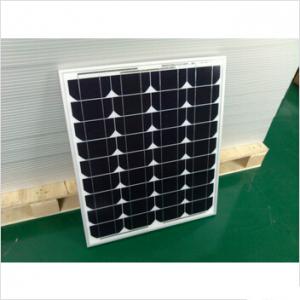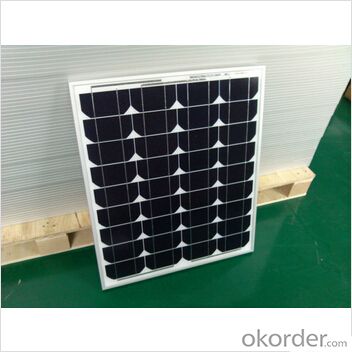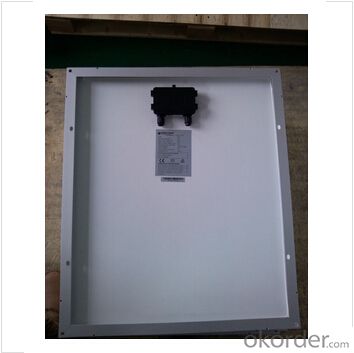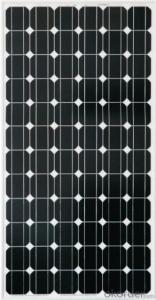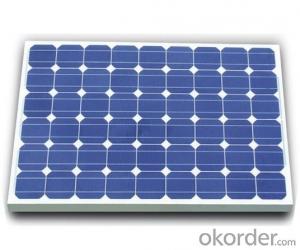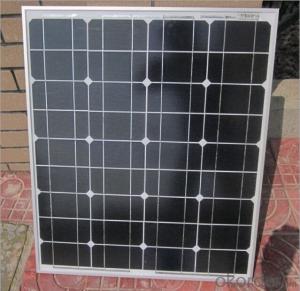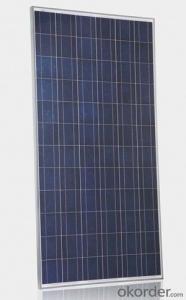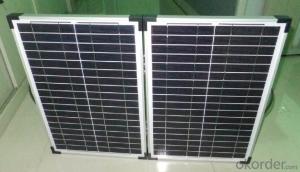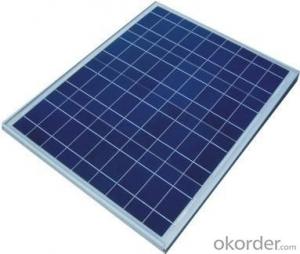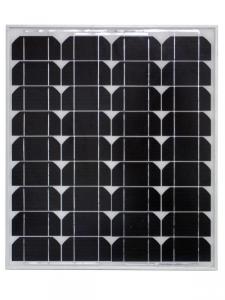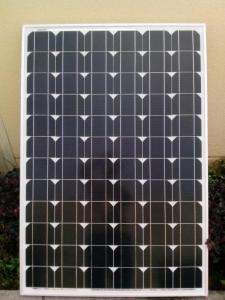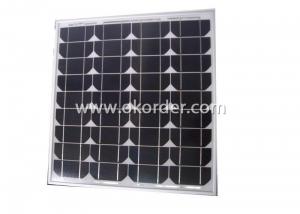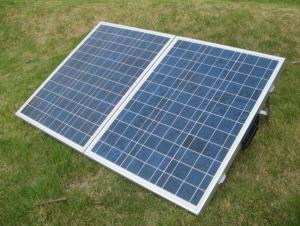Monocrystalline 40W PV Solar Panel Solar Module - Cost of Solar Panels Ma
- Loading Port:
- shanghaigang
- Payment Terms:
- TT or LC
- Min Order Qty:
- 6000 watt
- Supply Capability:
- 10000000 watt/month
OKorder Service Pledge
OKorder Financial Service
You Might Also Like
Description:
Solar modules use light energy (photons) from the sun to generate electricity through the photovoltaic effect.
The majority of modules use wafer-based crystalline silicon cells or thin-film cells based on cadmium telluride or silicon.
The structural (load carrying) member of a module can either be the top layer or the back layer.
Cells must also be protected from mechanical damage and moisture. Most solar modules are rigid, but semi-flexible ones are available,
based on thin-film cells. These early solar modules were first used in space in 1958.
CNBM Solar photovoltaic (PV) Panel is designed for large electrical power requirements.
It is the optimal choice for both on-grid and off-grid power systems.
CNBM Solar panel offers high performance of power per square foot of solar array.
Monocrystalline silicon(c-Si): often made using the Czochralski process. Single-crystal wafer cells tend to be expensive,
and because they are cut from cylindrical ingots, do not completely cover a square solar cell module without a substantial waste of refined silicon.
Hence most c-Si panels have uncovered gaps at the four corners of the cells.
Characteristics of Solar Monocrystalline
I. Solar Cell : High efficiency crystalline solar cell.
Even if under the weak light, the solar module can produce maximum power output.
II. Tempered glass (toughened glass): Anti-reflecting coating and high transmission rate glass increase
the power output and mechanical strength of solar module.
III. EVA and TPT: Using high quality EVA and TPT to prevent destroying and water.
IV. AI frame: Without screw, corner connection. 6 holes on the frame can be installed easily.
V. Junction box: Multi function junction box with water proof.
VI. Long lifetime: ≥25 years; Less power decrease.
VII. Good performance of preventing from atrocious weather such as wind and hails.
VIII. Resisting moisture and etching effectively, not effected by geology.
Advantages of Solar Monocrystalline
• CNBM Solar performance guarantees for 25 years
• 10 years guarantee for workmanship
• Timeliness of delivery
• Quality Products certified (TÜV, UL, CE, VDE, ISO)
Related Maximum Power(Pmax) | 40W |
Current at Pmax(Imp) | 2.33A |
Voltage at Pmax(Vmp) | 17.2V |
Short-Circuit Current(Isc) | 2.5A |
Open-Circuit Voltage(Voc) | 21.5V |
Module Dimension | 625*540*30mm |
Cel Type | 125*62.5mm Mono-crystalline |
Cell configuration | 36 (4*9)PCS in series |
Weight | 3.6kg |

FAQ:
1. How long will my inquiry get response?
Your inquiry related to our products or prices will be replied within 24 hours.
2. Can I get professional service and suggestion?
Well-trained and experienced staffs to answer all your questions in fluent English.
3. Do you accept OEM or customized design?
OEM & ODM, any your customized lightings we can help you to design and put into product.
4. What if I need specific design?
Distributorship are offered for your unique design and some our current models.
- Q: Can solar panels be used in combination with other renewable energy sources?
- Yes, solar panels can indeed be used in combination with other renewable energy sources. Many renewable energy systems today incorporate a mix of solar panels, wind turbines, hydropower, and geothermal energy to maximize efficiency and ensure a reliable and sustainable power supply. This combination of different renewable sources allows for a more balanced and consistent energy generation, reducing reliance on a single source and increasing overall system resilience.
- Q: Hello, I am shopping for solar panels for my home and there are so many to choose from. My house uses 40 Kw of power a day. If you had to choose from the output power of a solar panel from below, which one would you choose and why would you choose it? 2 Volts 4 Amps 48Watts2 Volts 8.5 Amps 02Watts6 Volts 7 Amps 2Watts24 Volts 4.2 Amps 00.8Watts24 Volts 8 Amps 95Watts
- The most energy effiecient PV cell in Australia at the moment is from First Solar they generate the most electricity compared to all units in Australia by an additional 6%. Not much but everything counts these days, especially with prices increasing over the next thress years (even without the CPRS) projections are (by IPART, who are the regulators that sets the electricity prices) rises by 46% (thats by Country Energy) and with the CPRS it was going to reach a 64% increase. The First Solar PV cells will give you a return on investment of around 2.75 years and generate electricity for 25 years (after 20 years they still generate Approx. 85% efficiency - best in market, I know I have been researching them for ages, and these are the ones I am installing !!!. Hope this helps. You need to choose a .5kW system, this will generate Approx $380pa
- Q: Can solar panels be installed on water pumps?
- Yes, solar panels can be installed on water pumps. Solar-powered water pumps are a great alternative to traditional pumps as they harness energy from the sun to power the pumping system. This not only reduces reliance on fossil fuels but also makes these pumps more versatile and suitable for remote areas where electricity may not be readily available.
- Q: Can solar panels be installed on a university campus or educational facility?
- Yes, solar panels can certainly be installed on a university campus or educational facility. In fact, many educational institutions have already embraced solar energy as a sustainable and cost-effective solution. Installing solar panels can help universities reduce their carbon footprint, save money on energy costs, and serve as an educational tool for students to learn about renewable energy.
- Q: Which kit did you use?How easy was it to build? How much did it cost to build the panels?How many kw or watts does it produce?Any other info on the kit or panels you built would be helpful.Thanks!
- Firstly, forget about making your own PV panels, while you can (if your chemistry is up to it and the home lab well tooled up) make a small PV cell, the efficiency will suck and you will never make enough to produce a reasonable amount of power. What you can do is to build your own solar thermal system to produce hot water (solar thermal makes better sense then PV in most domestic situations anyway), black painted central heating radiators under perspex, rockwool behind, small pump running a water/glycol mix through a heat exchanger controlled by some trivial electronics... Job done. As long as you don't try to run too hot, you can get a hundred watts or so of heat per square meter from such a solar thermal plant. Regards, Dan.
- Q: My Grandfather just purchased a cheap solar panel kit for his ranch that could not muster enough power to run his mini fridge.He has two 6 volt batteries running positive to negative and would like to add more batteries. Probably 2volt. How would he go about hooking up the other batteries and what kind of wire or coil should he use.Also, I saw on youtube a guy recommending a lead-acid battery from walmart for under $20. I was just going to go to ecology and just pick up some used batteries but I may be wrong.Any help for a first timer might help me and my gramps out will be appreciated.Thank you
- Solar charger employs solar energy to supply electricity to devices or charge batteries. They are generally portable. Solar array: electrical device consisting of a large array of connected solar cells Solar Panel is a group of solar cells arranged into a panel that can be installed onto a flat surface. The panel captures sunlight and converts it into DC power.
- Q: Where in the world are solar panels used. If it is used widespread across a continent just say which continent, other than that, just name the country. So where are solar panels used often?
- Solar panels can be used anywhere in the world. The only requirement is that there is sufficient sunlight to power the solar panels and in many developing countries, solar energy is used to heat water.
- Q: Im doing a science project and I need to know what gases or liquids a solar panel can make that is not friendly to the environment. Please name all the gases and liquids and explain how they damage the environment. It would be most likely that you will get best answer if you find all the bad things about solar energy and explain why they are bad and how they affect nature. that would be helpful to. Thank you
- Build okorder /
- Q: I wanna get a solar panel to charge or 2 car batteries. Then connect the battery to a 800watt power inverter so that I can power a tv. Will the 8watt solar panel charge my batteries and around in how long?I just wanna use the panel to charge the batteries, no to use the panel directly with my electronics. Thanks for your answer and help me with that.
- How about wind power? Check out this site, you can build one for under two hundred and get free batteries.
- Q: The intensity of sunlight at the distance of the Earth's orbit is 380 W/m2. An Earth-orbiting satellite has a solar panel that measures .35 m by 4.86 m, which converts solar energy to electrical energy with an efficiency of 26%. In one hour, how much electrical energy does the panel produce? Assume that the satellite's attitude control jets keep the panel oriented perpendicular to the incoming sunlight.
- This is pretty much an exercise in knowing units and dimensional analysis. Watts are in Joules/second. So every second a square with the area(meters^2) of meter^2 receives 380 joules from the sun. In your case the square is the solar panel. So find the area of the solar panel in m^2. If you multiply area times intensity you can see that the meters cancel out and you are left with Watts(J/s). Since you want the Joules received in an hour you again multiply by how many seconds are in an hour. Leaving you with joules. What you have now is the total energy, but your solar panel is only 26% efficient, so just multiply by .26 and you will have your energy.
Send your message to us
Monocrystalline 40W PV Solar Panel Solar Module - Cost of Solar Panels Ma
- Loading Port:
- shanghaigang
- Payment Terms:
- TT or LC
- Min Order Qty:
- 6000 watt
- Supply Capability:
- 10000000 watt/month
OKorder Service Pledge
OKorder Financial Service
Similar products
Hot products
Hot Searches
Related keywords
